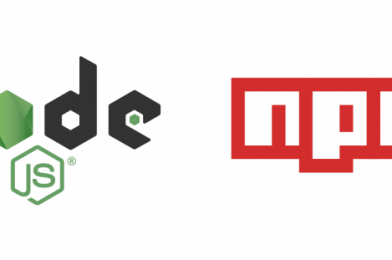- addcslashes — Quote string with slashes in a C style
- addslashes — Quote string with slashes
- bin2hex — Convert binary data into hexadecimal representation
- chop — Alias of rtrim
- chr — Return a specific character
- chunk_split — Split a string into smaller chunks
- convert_cyr_string — Convert from one Cyrillic character set to another
- convert_uudecode — Decode a uuencoded string
- convert_uuencode — Uuencode a string
- count_chars — Return information about characters used in a string
- crc32 — Calculates the crc32 polynomial of a string
- crypt — One-way string hashing
- echo — Output one or more strings
- explode — Split a string by string
- fprintf — Write a formatted string to a stream
- get_html_translation_table — Returns the translation table used by htmlspecialchars and htmlentities
- hebrev — Convert logical Hebrew text to visual text
- hebrevc — Convert logical Hebrew text to visual text with newline conversion
- hex2bin — Decodes a hexadecimally encoded binary string
- html_entity_decode — Convert all HTML entities to their applicable characters
- htmlentities — Convert all applicable characters to HTML entities
- htmlspecialchars_decode — Convert special HTML entities back to characters
- htmlspecialchars — Convert special characters to HTML entities
- implode — Join array elements with a string
- join — Alias of implode
- lcfirst — Make a string’s first character lowercase
- levenshtein — Calculate Levenshtein distance between two strings
- localeconv — Get numeric formatting information
- ltrim — Strip whitespace (or other characters) from the beginning of a string
- md5_file — Calculates the md5 hash of a given file
- md5 — Calculate the md5 hash of a string
- metaphone — Calculate the metaphone key of a string
- money_format — Formats a number as a currency string
- nl_langinfo — Query language and locale information
- nl2br — Inserts HTML line breaks before all newlines in a string
- number_format — Format a number with grouped thousands
- ord — Return ASCII value of character
- parse_str — Parses the string into variables
- print — Output a string
- printf — Output a formatted string
- quoted_printable_decode — Convert a quoted-printable string to an 8 bit string
- quoted_printable_encode — Convert a 8 bit string to a quoted-printable string
- quotemeta — Quote meta characters
- rtrim — Strip whitespace (or other characters) from the end of a string
- setlocale — Set locale information
- sha1_file — Calculate the sha1 hash of a file
- sha1 — Calculate the sha1 hash of a string
- similar_text — Calculate the similarity between two strings
- soundex — Calculate the soundex key of a string
- sprintf — Return a formatted string
- sscanf — Parses input from a string according to a format
- str_getcsv — Parse a CSV string into an array
- str_ireplace — Case-insensitive version of str_replace.
- str_pad — Pad a string to a certain length with another string
- str_repeat — Repeat a string
- str_replace — Replace all occurrences of the search string with the replacement string
- str_rot13 — Perform the rot13 transform on a string
- str_shuffle — Randomly shuffles a string
- str_split — Convert a string to an array
- str_word_count — Return information about words used in a string
- strcasecmp — Binary safe case-insensitive string comparison
- strchr — Alias of strstr
- strcmp — Binary safe string comparison
- strcoll — Locale based string comparison
- strcspn — Find length of initial segment not matching mask
- strip_tags — Strip HTML and PHP tags from a string
- stripcslashes — Un-quote string quoted with addcslashes
- stripos — Find the position of the first occurrence of a case-insensitive substring in a string
- stripslashes — Un-quotes a quoted string
- stristr — Case-insensitive strstr
- strlen — Get string length
- strnatcasecmp — Case insensitive string comparisons using a “natural order” algorithm
- strnatcmp — String comparisons using a “natural order” algorithm
- strncasecmp — Binary safe case-insensitive string comparison of the first n characters
- strncmp — Binary safe string comparison of the first n characters
- strpbrk — Search a string for any of a set of characters
- strpos — Find the position of the first occurrence of a substring in a string
- strrchr — Find the last occurrence of a character in a string
- strrev — Reverse a string
- strripos — Find the position of the last occurrence of a case-insensitive substring in a string
- strrpos — Find the position of the last occurrence of a substring in a string
- strspn — Finds the length of the initial segment of a string consisting entirely of characters contained within a given mask.
- strstr — Find the first occurrence of a string
- strtok — Tokenize string
- strtolower — Make a string lowercase
- strtoupper — Make a string uppercase
- strtr — Translate characters or replace substrings
- substr_compare — Binary safe comparison of two strings from an offset, up to length characters
- substr_count — Count the number of substring occurrences
- substr_replace — Replace text within a portion of a string
- substr — Return part of a string
- trim — Strip whitespace (or other characters) from the beginning and end of a string
- ucfirst — Make a string’s first character uppercase
- ucwords — Uppercase the first character of each word in a string
- vfprintf — Write a formatted string to a stream
- vprintf — Output a formatted string
- vsprintf — Return a formatted string
- wordwrap — Wraps a string to a given number of characters
Day: August 7, 2021
How to use Transition property in CSS?
Transitions is used to change property values from one value to another, over a given duration. The transition effect will start when the specified CSS property changes value.
How to Use Transitions?
- CSS property you want to add an effect to
- Duration of the effect

Note: If the duration part is not specified, the transition will have no effect, because the default value is 0.
Transition–
- transition-timing-function
- transition-property
- transition-duration
- transition-delay
- transition
transition-property–
This property is used to specify the name of the CSS property the transition effect is for (the transition effect will start when the specified CSS property changes). Always specify the transition-duration property, otherwise the duration is 0, and the transition will have no effect.
We can set this property to none, all and property.
Ex: –
div { transition-property: all; }
none – No property will get a transition effect
all – All properties will get a transition effect. This is Default value.
property – Defines a comma separated list of CSS property names the transition effect is for

transition-duration–
This property is used to specify how many seconds or milliseconds a transition effect takes to complete. We can set this property to time in the form of seconds or milliseconds. The default value of this property is 0s which means there will be no effect.
Ex:-
div { transition-duration: 2s; }
div { transition-duration: 1000ms; }
transition-timing-function–
This property is used to specify the speed curve of the transition effect. This property allows a transition effect to change speed over its duration. We can set this property to ease, linear, ease-in, ease-out, ease-in-out, step-start, step-end, steps(int, start or end), cubic-bezier(n, n, n, n).
Ex:-
div { transition-timing-function: ease-in; }
- ease – It Specifies a transition effect with a slow start, then fast, then end slowly (equivalent to cubic-bezier(0.25, 0.1, 0.25, 1)). This is Default value.
- linear – It specifies a transition effect with the same speed from start to end (equivalent to cubic-bezier(0, 0, 1, 1))
- ease-in – It specifies a transition effect with a slow start (equivalent to cubic-bezier(0.42, 0, 1, 1))
- ease-out – It specifies a transition effect with a slow end (equivalent to cubic-bezier(0, 0, 0.58, 1))
- ease-in-out – It specifies a transition effect with a slow start and end (equivalent to cubic-bezier(0.42, 0, 0.58, 1))
- step-start – Equivalent to steps(1, start)
- step-end – Equivalent to steps(1, end)
- steps(int, start or end) – Specifies a stepping function, with two parameters. The first parameter specifies the number of intervals in the function. It must be a positive integer (greater than 0). The second parameter, which is optional, is either the value “start” or “end”, and specifies the point at which the change of values occur within the interval. If the second parameter is omitted, it is given the value “end”
- cubic-bezier(n,n,n,n) – Define your own values in the cubic-bezier function. Possible values are numeric values from 0 to 1

transition-delay–
This property is used to specify when the transition effect will start. We can set this property to time in the form of seconds or milliseconds.
Ex:-
div { transition-delay: 2s; }
div { transition-delay: 1000ms; }
How to use text-decoration property in CSS?
This property is used to specify the decoration added to text.
- text-decoration-line
- text-decoration-style
- text-decoration-color
- text-decoration
text-decoration-line
This property is used to specify what type of line the decoration will have. We can set this property to none, underline, overline, line-through
We can combine more than one value, like underline and overline to display lines both under and over the text.
Ex:-
h1 { text-decoration-line: underline;}
h1 { text-decoration-line: underline overline;}
text-decoration-style–
This property is used to specify how the line will display.
We can set this property to solid, double, dotted, dashed, wavy.
Ex:-
h1 { text-decoration-line: underline; text-decoration-style: dotted; }text-decoration-color–
This property is used to specify the color of the text-decoration-line.
Ex:-
h1 { text-decoration-line: underline; text-decoration-color: red; }text-decoration–
This is shorthand of all three text-decoration properties.
Syntax: –
Selector {text-decoration: text-decoration-line text-decoration-style text-decoration-color}
Ex:-
h1 { text-decoration: underline dotted red ; }


Difference between innerHTML and outerHTML in JavaScript
innerHTML
The Element property innerHTML gets or sets the HTML or XML markup contained within the element.
Setting the value of innerHTML lets you easily replace the existing contents of an element with new content.
HTML5 specifies that a <script> tag inserted with innerHTML should not execute.
It is recommended you should not use innerHTML when inserting plain text; instead, use textContent.
outerHTML
The outerHTML is the HTML of an element including the element itself. Use the outerHTML when you want to completely replace an element and its contents. Use innerHTML when you only want to replace the contents of the element.
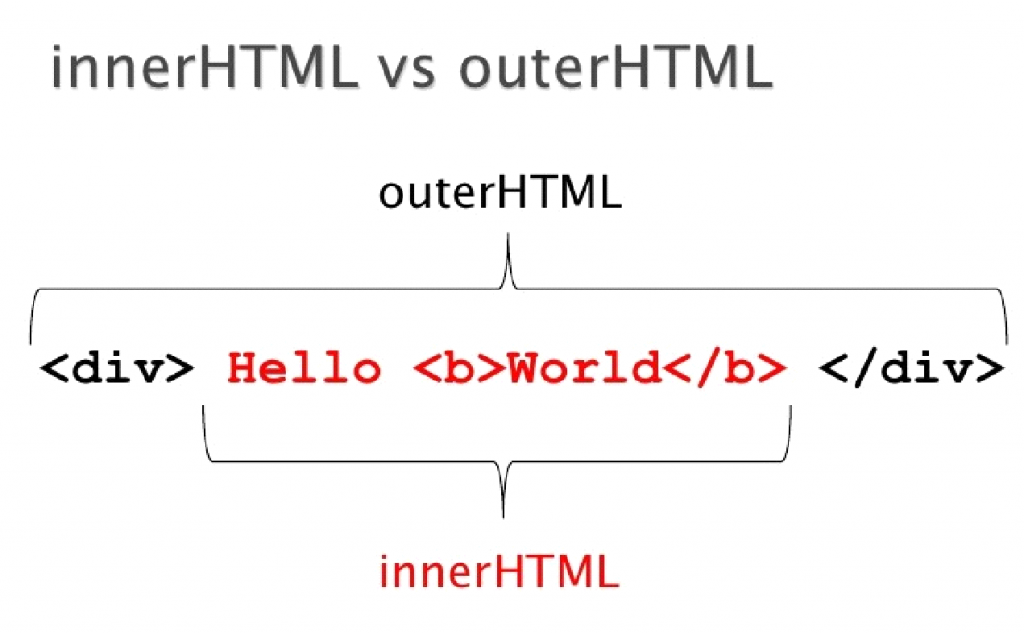
What is the difference between innerText and outerText?
The innerText property works similarly to the innerHTML property, except that it is focused solely on the textual content contained within an element. The innerText property sets or returns the text content of the specified node, and all its descendants. If you set the innerText property, any child nodes are removed and replaced by a single Text node containing the specified string. This feature was originally introduced by Internet Explorer and was formally specified in the HTML standard in 2016 after being adopted by all major browser vendors. To set or return the HTML content of an element, use the innerHTML property.
outerText
outerText property works similarly to the outerHTML property, modifies the element itself, and replaces it with a single text node. This feature is non-standard and is not on a standards track. Do not use it on production sites facing the Web: it will not work for every user.
error in ./resources/assets/sass/app.scss
If you are getting this error (error in ./resources/assets/sass/app.scss) in Node module please follow some steps which is have mentioned in the following
Error:-
Many of you get this error when you did not change anything in app.scss, but when I run npm run watch I get the following errors:
error in ./resources/sass/app.scss
Module build failed (from ./node_modules/sass-loader/lib/loader.js):
Unsupported operation: Cannot extract a file path from a URI with a fragment component
@ ./resources/sass/app.scss 2:14-254
Asset Size Chunks Chunk Names
/js/app.js 2.46 MiB /js/app [emitted] /js/app
ERROR in ./resources/sass/app.scss
Module build failed (from ./node_modules/css-loader/index.js):
ModuleBuildError: Module build failed (from ./node_modules/sass-loader/lib/loader.js):
undefined
^
Join(null, "variables"): part 0 was null, but part 1 was not.
@import 'variables';
^^^^^^^^^^^
stdin 2:9 root stylesheet
in C:\Users\TAQI VAHEED\Desktop\#Coding\resPro\resources\sass\app.scss (line 2, column 9)
at runLoaders (C:\Users\TAQI VAHEED\Desktop\#Coding\resPro\node_modules\webpack\lib\NormalModule.js:30
at C:\Users\TAQI VAHEED\Desktop\#Coding\resPro\node_modules\loader-runner\lib\LoaderRunner.js:364:11
at C:\Users\TAQI VAHEED\Desktop\#Coding\resPro\node_modules\loader-runner\lib\LoaderRunner.js:230:18
at context.callback (C:\Users\TAQI VAHEED\Desktop\#Coding\resPro\node_modules\loader-runner\lib\Loader
13)Solution:-
The main issue which we have found that is related to dart-sass being used instead of node-sass with laravel
You have to just follow one step:-
Step 1:- You have to run this Command and all the things will solve .
npm install node-sassTop 10 Website to Host Git Repository Online
In any industry, code has become one of the most business-critical assets. As a result, storing, securing, and collaborating around code has become a significant challenge for enterprises large and small.
Choosing the right source code management solution is no easy task. Even more so when you think about hosting your code behind your own firewall.
This post takes you through this decision – starting with a few common questions.
One of the first questions you’ll need to answer for yourself is: do you have the resources and expertise to professionally manage your code’s on-premises hosting?
1. Is On-Premise Hosting the Right Choice for You?
Any IT department must follow strict security policies. If your organization’s policies require you to keep your code in-house, then of course you will have to deal with hosting your code behind your firewall.
However, self-hosting your code is not a decision you should rush. There is much to keep in mind.
Security:
In an on-premises scenario, your IT department is responsible for setting up a secure environment and installing relevant updates consistently. Keeping a server secure and properly maintained is nothing to be taken lightly.
Availability / Backups:
Today, the code is important to many areas within the company. Therefore its permanent availability is often important. You should make sure that your server has little or no downtime.
Also, note that losing code can be a life-threatening event for many enterprises. You need to provide a completely fail-safe and complete backup strategy in order to make data loss impossible.
Integrations:
Also, think about other systems that need to interact with your code repository. Things like continuous integration servers or issue tracking systems can be other important parts of your software cycle.
Make sure they can be integrated with your code hosting platform – whether it’s behind a firewall or in the cloud.
Budget:
Depending on your needs, the size of your team, and the number of repositories, different solutions come at wildly different prices. This is true for both self-hosted installations and online services. You need to make sure that your own IT department can handle core subjects like security and maintenance flawlessly.
2. Commercial or OpenSource?
As of today, almost all source code hosting options are commercial systems. In fact, the main argument for paying a really high price sometimes is the professional support that it includes. For further updates in case of problems/queries, you can count on the professionals who help you.
If you don’t need these services, you can consider an open-source solution.
3. Complementing Tools
As with most solutions, the actual task of “source code management” is only part of their offering. This makes sense if you consider that today, software development involves a myriad of different tools and workflows – the ones that work best when tightly integrated with one another. Think issue tracking, code reviews, continuous integration systems, etc.
Here is the list of Top 10 Website to Host Git Repository Online:
1. Amazon AWS CodeCommit:

Amazon’s AWS platform includes hosting for Git repositories. It also comes with features that facilitate collaboration, such as code review and access control.
AWS CodeCommit is a secure, highly scalable, managed source control service that hosts private Git repositories. It makes it easy for teams to collaborate on code securely, including encrypted contributions in transit and at rest. CodeCommit eliminates the need for you to manage your own source control system or worry about scaling up its infrastructure. You can use CodeCommit to store anything from code to binaries. It supports the standard functionality of Git, so it works seamlessly with your existing Git-based tools.
Benefits:
- Fully managed
- Secure
- High availability
- Faster development lifecycle
- Use your existing tools
- Collaborate on code
2. Assembla:

Assembla has a long history in the business with its Subversion hosting. It includes a “workspace” platform with issue management, time tracking, and collaboration tools such as Wiki and its own messaging system.
It is a source code management tool that specializes in providing cloud-based version control services for code projects and agile software development. They provide an additional project management tool for those who use their cloud repositories.
Features:
- Work together with Git merge requests
- Collaboration
- Integrated Issue Tracking
- Security
- Package Management
- Project Management
- Code Analysis
3. Beanstalk:

Being a very lean and reliable service, Beanstalk is a great option for businesses. It provides its own “deployment” infrastructure and integrates well with other tools such as Zendesk, FogBugz, Basecamp, or Lighthouse.
Features:
- Easy-to-use service for deploying.
- Scaling web applications
- Services developed with Java
- Backup / Recovery
- Development Environment
- Testing
4. Bitbucket:
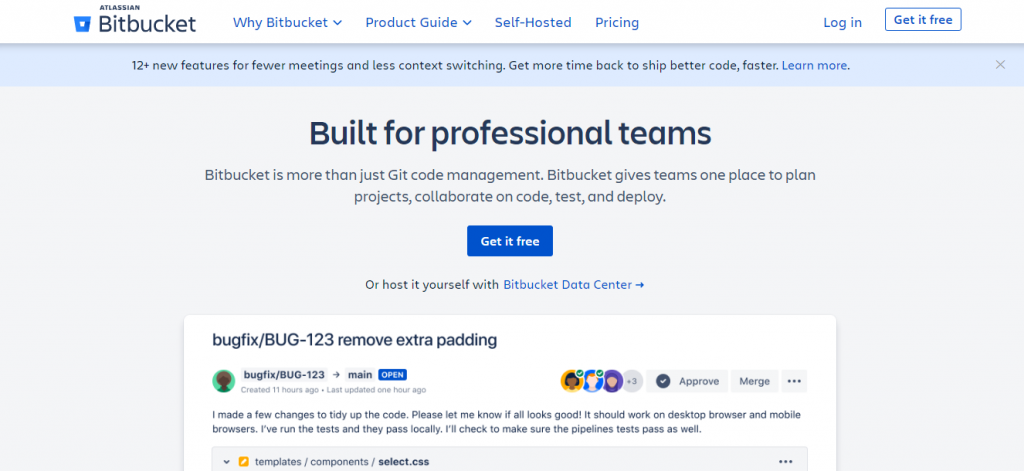
Bitbucket, one of the giants in the industry.
The biggest advantage of Bitbucket Server is certainly that it comes from Atlassian – the company that develops highly popular products like JIRA and Confluence. This is why the integration with these tools (especially JIRA) in BitBucket Server is seamless.
BitBucket Server is an obvious choice if your development toolchain already relies on other Atlassian products like JIRA and Bamboo.
Features:
- Merge Checks.
- Code search
- Git Large File Storage
- Bitbucket Pipelines
- IP whitelisting.
5. Codebase:
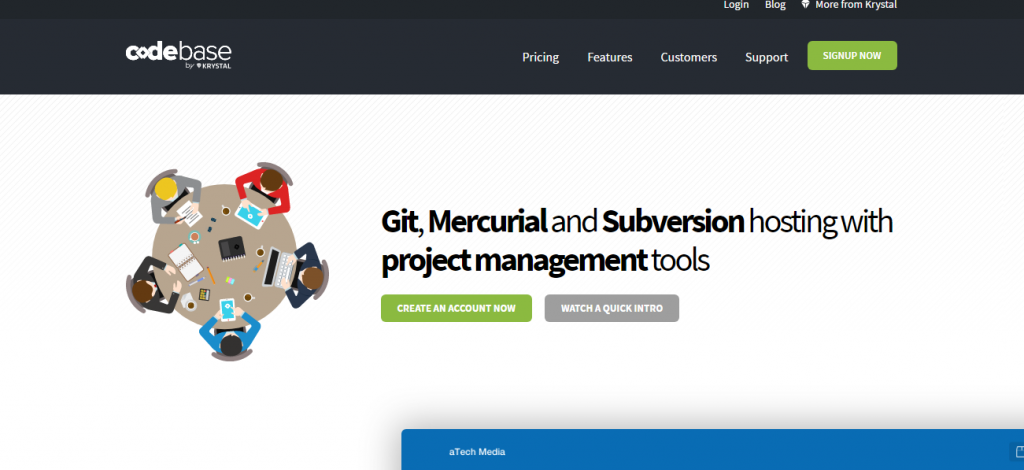
One of the few platforms to support Git, Subversion, and Mercurial. Additionally, ticketing, project management, and deployment infrastructure tools are included. The codebase is packed with features to help you manage your code and your project with ease.
Features:
- Repository Hosting
- Exception Tracking
- Time Tracking
- Customizable Permissions
- Complete Developer API
- Powerful Searching & Filtering
- Custom Branding
6. RhodeCode:
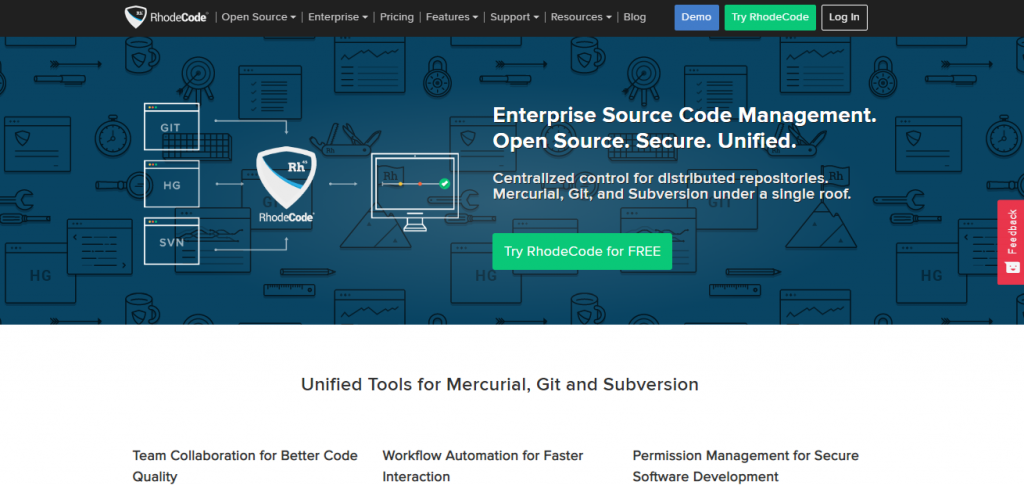
Sophisticated code review and approval system including news feed and mention system. With features like LDAP support and IP restrictions, Roadcode seems to be geared for corporate use.
Roadcode allows developers to use not only Git but Mercurial and Subversion for revision control. Feature-wise, the platform offers the most important collaboration features such as code reviews and pull requests – but banks on flexible integration with external tools for both issue tracking and continuous integration.
Features:
- Advanced code reviews.
- Side-by-side diffs.
- Pull requests.
- Inline source code chat.
- Full-text code search and source code indexing.
- Web-based file adding, editing, deletion.
7. SourceForge:

SourceForge is an open-source community resource that is dedicated to helping you succeed as much as possible in open-source projects. We thrive on community collaboration to help make it a premier resource for open-source software development and distribution.
A classic hosting site whose reputation took a turn for the worse in the early 2010s after some shady practices, SourceForge has been under new ownership since 2016 and is determined to restore its good reputation.
Features:
- Unlimited bandwidth for Open Source projects
- Integrated Issue Tracking
- Spambot protection
- Extensive worldwide mirror network
- Download statistics over time, by platform, and by region.
- Analytics is completely free, takes no time to set up.
- Automatic platform detection
8. Perforce Helix:

Perforce has the longest history in source code management of all the companies in this overview. It is mostly known for having an impressive tradition in enterprise code hosting through its own Perforce version control system. Recently, however, the company expanded its offering with its new Helix4Git platform.
Features:
- Security and scalability
- By mirroring work into a Perforce server
- Specific branches and files can be locked
Especially will large companies appreciate the long-term experience Perforce as source code management provider; Enterprises can ensure that is well understood their needs and requirements.
9. GitHub:

GitHub is an increasingly popular programming resource that is used to share the access code. It is a social networking site for programmers that use a large range of companies and organizations’ project management and collaboration.
Undisputed number one in the open-source world is having projects like Ruby on Rails or jQuery hosted on GitHub. Offerings include great code review and collaboration features.
Features:
- Drag and Drop Gist Code.
- Creating a folder via the Web Interface
- Using Git URL Shortener.
- Task Checklist.
- Using Github Command Line Interface.
10. GitLab:

GitLab is a web-based Git repository that offers free open and private repositories, issue-following capabilities, and wikis. This is a full DevOps platform that enables all tasks to professionals from the project planning and source code management, monitoring, and security. It allows teams to collaborate and build better software.
With open-source background, GitLab code provides the perfect platform to develop at a rapid pace for cooperation. The free Community Edition and Enterprise Edition can be installed on your own servers. A hosted offering running on GitLab.com is also available.
Features:
- Offers git repository management.
- Code Reviews
- Issue tracking
- Activity feeds and wikis
GitLab teams product helps increase reducing lifecycle and productivity, which creates value for customers return.
There’s a good chance that one of these solutions is the perfect choice for your requirements.
‘cross-env’ is not recognized as an internal or external command, operable program or batch file.
Hey if you are getting some error like (‘cross-env’ is not recognized as an internal or external command, operable program or batch file.) in your Node please follow the steps which i have mentioned in following:-
You need to make cross-env working globally instead of having it in the project.
Step 1:- remove node_modules folder
Step 2:- run this Command so that you cross-env work globally.
npm install --global cross-envStep 3:- Remove “cross-env”: “5.0.1” from the devDependencies section of the package.json file. You may actually skip this step and keep package.json. If you’d want.
Step 4:- Then run this command.
npm install --no-bin-linksStep 5:- After this finally you can run your main command
npm run devInsert( ) Method in JavaScript
The insertBefore() method is used to insert a node before the reference node as a child of a specified parent node. If the given child is a reference to an existing node in the document, insertBefore( ) moves it from its current position to the new position.
If referenceNode is null, the newNode is inserted at the end of the list of child nodes.
Syntax: –
parentNode.insertBefore(newNode, referenceNode);
insertAdjacentElement ( ) Method
The insertAdjacentElement() method inserts the specified element into a given specified position. It returns the element that was inserted, or null if the insertion failed.
Syntax:-
element – The element to be inserted into the tree.
The beforebegin and afterend positions work only if the node is in a tree and has an element parent.
insertAdjacentHTML ( ) Method
The insertAdjacentHTML() method is used to insert a text as HTML (parses the specified text as HTML or XML) into a specified position.
Syntax:-
text – The string to be parsed as HTML or XML and inserted into the tree.
It is recommended you not use insertAdjacentHTML when inserting plain text instead, use the node.textContent property
insertAdjacentText ( ) Method
The insertAdjacentText() method inserts the specified element into a specified position.
Syntax:-
text – The text which is about to insert.
The beforebegin and afterend positions work only if the node is in a tree and has an element parent.
What is AWS? Who can learn this certification course?
If you are new to the world of cloud computing, you will want to select a cloud platform that can help you easily get started with learning cloud computing. It is extremely important for one to familiarize themselves with various leading cloud service providers before deciding which cloud is best to get started with a career in cloud computing. Both AWS and Azure are solid performers with equivalence in almost 99% of the use cases.
What is AWS?
Amazon Web Services (AWS) is a secure cloud services platform, offering compute power, database storage, content delivery and other functionality to help businesses scale and grow. It is a subsidiary of Amazon providing on-demand cloud computing platforms.

AWS has significantly more services, and more features within those services, than any other cloud provider–from infrastructure technologies like compute, storage, and databases–to emerging technologies, such as machine learning and artificial intelligence, data lakes and analytics, and Internet of Things. AWS has the largest and most dynamic community, with millions of active customers and tens of thousands of partners globally.
Customers across virtually every industry and of every size, including startups, enterprises, and public sector organizations, are running every imaginable use case on AWS. It is architected to be the most flexible and secure cloud computing environment available today.
Here’s an overview of the certifications offered by AWS and capabilities an individual validates by completing these certifications.
AWS certifications offered include:

AWS Certified Cloud Practitioner
- Individuals are expected to effectively demonstrate a comprehensive understanding of AWS fundamentals and best practices.
AWS Certified Solutions Architect – Associate
- Individuals in an associate solutions architect role have 1+ years of experience designing available, fault-tolerant, scalable, and most importantly cost-efficient, distributed systems on AWS.
- Can demonstrate how to build and deploy applications on AWS.
AWS Certified SysOps Administrator – Associate
- This certification is meant for systems administrators that hold a systems operations role and have at least one year of hands-on experience in management, operations and deployments on AWS. They must be able to migrate on-premises workloads to AWS.
- They can estimate usage costs and identify operational cost control methods.
- Must prove knowledge of deploying, operating and managing highly available, scalable and fault-tolerant systems on AWS.
AWS Certified Developer – Associate
- This is for individuals who hold a development role and have at least one or more years of experience developing and maintaining AWS-based applications.
- Display a basic understanding of core AWS services, uses, and basic AWS architecture best practices.
- Demonstrate that they are capable of developing, deploying, and debugging cloud-based applications using AWS.
AWS Certified Solutions Architect – Professional
- Individuals in a professional solutions architect role have two or more years of experience operating and managing systems on AWS.
- They must be able to design and deploy scalable, highly available, and fault-tolerant applications on AWS.
- Must demonstrate knowledge of migrating complex, multi-tier applications on AWS
- They are responsible for implementing cost-control strategies.
AWS Certified DevOps Engineer – Professional
- Intended for individuals who have a DevOps engineer role and two or more years of experience operating, provisioning and managing AWS environments.
- They are able to implement and manage continuous delivery systems and methodologies on AWS.
- Additionally, they must be able to implement and automate security controls, governance processes, and compliance validation.
- Can deploy and define metrics, monitoring and logging systems on AWS.
- Are responsible for designing, managing, and maintaining tools that automate operational processes.
AWS Certified Advanced Networking – Speciality
- Intended for individuals who perform intricate networking tasks.
- Design, develop, and deploy cloud-based solutions using AWS
- Design and maintain network architecture for all AWS services
- Leverage tools to automate AWS networking tasks
AWS Certified Big Data – Speciality
- For individuals who perform complex Big Data analyses and have at least two years of experience using AWS.
- Implement core AWS Big Data services according to basic architecture best practices
- Design and maintain Big Data
- Leverage tools to automate data analysis
AWS Certified Security – Speciality
- Individuals who have a security role and at least two years of hands-on experience securing AWS workloads.
- Exhibit an understanding of specialized data classifications and AWS data protection mechanisms as well as data encryption methods and secure Internet protocols and AWS mechanisms to implement them
- Knowledge of AWS security services and features to provide a secure production environment
- An understanding of security operations and risk
AWS Certified Machine Learning – Speciality
- Intended for individuals in a development or data science role.
- Ability to design, implement, deploy and maintain machine learning solutions for specific business problems.
AWS Certified Alexa Skill Builder – Speciality
- Intended for individuals who have a role as an Alexa skill builder.
- Individuals have demonstrated an ability to design, build, test, publish and manage Amazon Alexa skills.
Where to Start
If you aren’t sure where to start, Best institute are a great way to help you get the ball rolling in your cloud certification journey, they offering comprehensive AWS certification course led by the experts in the programme. They trained and prepare you for the AWS certification exam. You will also learn the best practices to be followed while working on AWS projects in the industry. This Certification is completely hands-on and designed in a way to help you become technical expertise. I would like to suggest you some institutes which can meet your expectation. these institutes are:
And also if you are looking for Free online resources and quality training videos of AWS Certification on online platform like YouTube then you can also check ScmGalaxy and DevOpsSchool YouTube channel.
By ScmGlaxy
By DevOpsSchool
Good Luck !!!
How is Node.js created with JavaScript?
Creating Nodes
- createElement(element_name)
- createTextNode(string)
- createComment(string)
- createDocumentFragment( )
Create Element Node
The createElement(element_name) method is used to create the HTML element specified by tagName, or an HTMLUnknownElement if tagName isn’t recognized. It returns the New Element.
Syntax:-
createElement(element_name)
Create Text Node
The createTextNode(string) method is used to create the Text Node with the specified text (string).
Syntax:-
createTextNode(string)
Create Comment Node
The createComment(string) method is used to create the Comment Node with the specified string and returns it.
Syntax:-
createComment (string)
Document Fragment
- The DocumentFragment interface represents a minimal document object that has no parent.
- A common use for Document Fragment is to create one, assemble a DOM subtree within it, then append or insert the fragment into the DOM using Node interface methods such as appendChild( ) or insertBefore( ).
- Document fragment isn’t part of the active document tree structure, changes made to the fragment don’t affect the document.
- Doing this moves the fragment’s nodes into the DOM, leaving behind an empty Document Fragment.
- An empty Document Fragment can be created using the document.createDocumentFragment() method.
Create Document Fragment
The createDocumentFragment() method creates a imaginary Node object, with all the properties and methods of the Node object.

